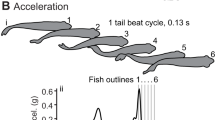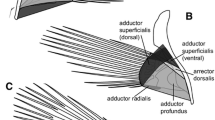Abstract
We quantified the intensity and duration of electromyograms (emgs) from the red and white axial muscles in five bluegill sunfish (Lepomis macrochirus) which performed three categories of behavior including steady swimming and burst and glide swimming at moderate and rapid speeds. Steady swimming (at 2 lengths/s) involved exclusively red muscle activity (mean posterior emg duration = 95 ms), whereas unsteady swimming utilized red and white fibers with two features of fiber type recruitment previously undescribed for any ectothermic vertebrate locomotor muscle. First, for moderate speed swimming, the timing of red and white activity differed significantly with the average onset time of white lagging behind that of red by approximately 40 ms. The durations of these white emgs were shorter than those of the red emgs (posterior mean = 82 ms) because offset times were effectively synchronous. Second, compared to steady and moderate speed unsteady swimming, the intensity of red activity during rapid unsteady swimming decreased while the intensity of white muscle activity (mean white emg duration = 33 ms) increased. Decreased red activity associated with increased white activity differs from the general pattern of vertebrate muscle recruitment in which faster fiber types are recruited in addition to, but not to the exclusion of, slower fiber types.
Similar content being viewed by others
References
Armstrong RB (1981) Recruitment of muscles and fibres within muscles in running animals. Symp Zool Soc Lond 48: 289–304
Bone Q (1966) On the function of the two types of myotomal muscle fibre in elasmobranch fish. J Marine Biol Assoc UK 46: 321–349
Bone Q (1978) Locomotor muscle. In: Hoar WS, Randall DJ (eds) Fish physiology vol. 7. Locomotion. Academic Press, New York, pp 361–424
Bone Q, Kicenuik J, Jones DR (1978) On the role of the different fibre types in fish myotomes at intermediate swimming speeds. Fish Bull 76: 691–699
Eaton RC, Lavender WA, Wieland CM (1982) Alternative neural pathways initiate fast-start responses following lesions of the Mauthner neuron in goldfish. J Comp Physiol 145: 485–496
Fetcho JR (1986) The organization of the motoneurons innervating the axial musculature of vertebrates. I. Goldfish (Carassius auratus) and mudpuppies (Necturus maculosus). J Comp Neurol 249: 521–550
Fetcho JR (1991) Spinal network of the Mauthner cell. Brain Behav Evol 37: 298–316
Fetcho JR, Faber DS (1988) Identification of motoneurons and interneurons in the spinal network for escapes initiated by the Mauthner cell in goldfish. J Neurosci 8: 4192–4213
Grillner S (1981) Control of locomotion in bipeds, tetrapods, and fish. In: Brooks VB (ed) Handbook of physiology, sec. 1, Brookhart JM, Mountcastle VB (eds) vol. 2, Motor control. American Physiological Society, Bethesda, pp 1179–1236
Henneman E, Somjen G, Carpenter DO (1965) Functional significance of cell size in spinal motoneurons. J Neurophysiol 28: 560–580
Hudson RCL (1973) On the function of the white muscles in teleosts at intermediate speeds. J Exp Biol 58: 509–522
Jayne BC (1988) Muscular mechanism of snake locomotion: An electromyographic study of lateral undulation of the Florida banded water snake (Nerodia fasciata) and the yellow rat snake (Elaphe obsoleta). J Morphol 197: 159–181
Jayne BC, Bennett AF, Lauder GV (1990a) Muscle recruitment during terrestrial locomotion: how speed and temperature affect fibre type use in a lizard. J Exp Biol 152: 101–128
Jayne BC, Lauder GV (1993) Red and white muscle activity and kinematics of the escape response of the bluegill sunfish during swimming. J Comp Physiol A 173: 495–508
Jayne, BC, Lauder, GV, Reilly, SM, Wainwright, PC (1990b) The effect of sampling rate on the analysis of digital electromyograms from vertebrate muscle. J Exp Biol 154: 557–565
Johnson TP, Syme DA, Lauder GV, Bennett AF (1994) Modeling red muscle power output during steady and unsteady swimming in largemouth bass (Micropterus salmoides): a comparison of in vitro and in vivo function. Am J Physiol (Regulatory Integrative Comp Physiol) (in press)
Johnston IA (1983) Dynamic properties of fish muscle. In: Webb PW, Weihs D (eds) Fish Biomechanics. Praeger Publishers, New York, pp 36–67
Johnston IA, Moon TW (1980) Endurance exersize training in the fast and slow muscles of a teleost fish (Pollachius virens). J Comp Physiol 135: 147–156
Johnston IA, Davison W, Goldspink G (1977) Energy metabolism of carp swimming muscles. J Comp Physiol 114: 203–216
Lauder, GV, Liem, KF (1983) The evolution and interrelationships of the actinopterygian fishes. Bull Mus Comp Zool Harvard 150: 95–197
Lee RKK, Eaton RC (1991) Identifiable reticulospinal neurons of the adult zebrafish (Brachydanio rerio). J Comp Neurol 304: 34–52
Liu DW, Westerfield M (1988) Function of identified motoneurons and co-ordination of primary and secondary motor systems during zebra fish swimming. J Physiol (Lond) 403: 73–89
Nardone AC, Romano M, Schieppati (1989) Selective recruitment of high-threshold human motor units during voluntary isotonic lengthening of active muscles. J Physiol (Lond) 409: 451–471
Rayner MD, Keenan MJ (1967) Role of red and white muscles in the swimming of the skipjack tuna. Nature 214: 392–393
Rome LC, Sosnicki AA (1991) Myofilament overlap in swimming carp II. Sarcomere length changes during swimming. Am J Physiol 260 (Cell Physiol): C289-C286
Rome LC, Loughna PT, Goldspink G (1984) Muscle fiber activity in carp as a function of swimming speed and muscle temperature. Am J Physiol 247: R272-R279
Rome LC, Funke RP, Alexander RM, Lutz G, Aldridge H, Scott F, Freadman M (1988) Why animals have different muscle fibre types. Nature 335: 824–827
Rome LC (1986) The influence of temperature on muscle and locomotory performance. In: Heller HC, Musacchia XJ, Wang LCH (eds) Living in the cold: Physiological and biochemical adaptations: Proceedings of the Seventh International Symposium on Mammalian Hibernation. Elsevier, New York, pp 485–495
Rome LC, Choi I-H, Lutz G, Sosnicki A (1992) The influence of temperature on muscle function in the fast swimming scup I. Shortening velocity and muscle recruitment during swimming. J Exp Biol 163: 259–279
Rome LC, Loughna PT, Goldspink G (1985) Temperature acclimation: improved sustained swimming performance in carp at low temperatures. Science 228: 194–196
Smith JL, Betts B, Edgerton VR, Zernicke RF (1977) Rapid ankle extension during paw shakes: selective recruitment of fast ankle extensors. J Neurophysiol 43: 612–620
Van Leeuwen JL, Lankheet MJM, Akster HA, Osse JWM (1990) Function of red axial muscles of carp (Cyprinus carpio): recruitment and normalized power output during swimming in different modes. J Zool (Lond) 220: 123–145
Westerfield M, McMurray JV, Eisen JS (1986) Identified motoneurons and their innervation of axial muscles in the zebrafish. J Neurosci 6(8): 2267–2277
Williams TL, Grillner S, Smoljaninov VV, Wallén P, Kashin S, Rossignol S (1989) Locomotion in lamprey and trout: the relative timing of activation and movement. J Exp Biol 143: 559–566
Yasargil GM, Diamond J (1968) Startle-response in teleost fish: An elementary circuit for neural discrimination. Nature 220: 241–243
Zottoli SJ (1977) Correlation of the startle reflex and Mauthner cell auditory responses in unrestrained goldfish. J Exp Biol 66: 243–254
Author information
Authors and Affiliations
Rights and permissions
About this article
Cite this article
Jayne, B.C., Lauder, G.V. How swimming fish use slow and fast muscle fibers: implications for models of vertebrate muscle recruitment. J Comp Physiol A 175, 123–131 (1994). https://doi.org/10.1007/BF00217443
Accepted:
Issue Date:
DOI: https://doi.org/10.1007/BF00217443




